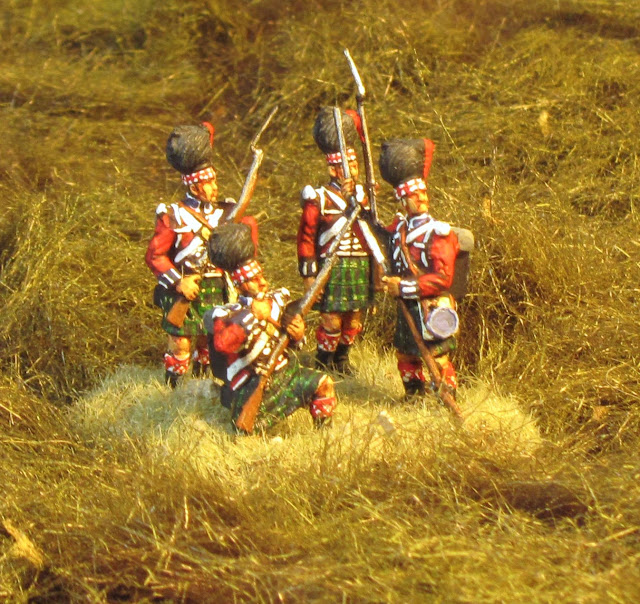Another project I completed early this summer were these 42nd Highlanders (Black Watch) as the newest addition to my British Peninsular army. I hope to add more Highlander regiments in the future, but I enjoyed painting this first set of Italeri figures. I was a bit daunted by the dreaded kilt but was happy with the result.
 |
| The full battalion. |
For the most part the figures are straight out of the box, but a lack of command figures in this set had me getting my scalpel and modelling compound out. One of the ensigns is adapted from the drummer (with different legs, as the drummer in this kit is diminutive!) and with the second I got lazy, and decided the ensign has been replaced by one of the sergeants of the colour party, with a fairly easy conversion of a pike-bearing sergeant.
The officer was adapted from the officer in the uninspired Hat British Light Infantry set, receiving a bearskin, officer, sash and claymore, held in a more realistic manner.
All the sergeants received the proper sash, worn over the shoulder, and claymores were added to those in the colour party.
I think future Highlander Regiments may have to wait as the command conversions were fun but a bit time consuming and I have my eye on some of the very nice looking Strelets sets of Highlanders that are now available.
 |
| The sergeants received their proper sashes but I ran out of steam and only gave claymores to the colour party. |
 |
| Infantry stand |
So a bit of history for this illustrious regiment...
The 42nd (Royal Highland) Regiment
After the Jacobite rising of 1715 Highland militias were raised from clans loyal to the British crown to keep control of Scotland. These six companies of Highlanders, with companies drawn from different clans (one company each coming from Clan Munro, Clan Fraser of Lovat, and Clan Grant and three from Clan Campbell) eventually became known as the Black Watch, probably as a result of how they dressed. Four more were added in 1739 at which time they were officially formed into the 43rd Highland Regiment of Foot.
The first battalion embarked for Portugal in August, 1808 and was present at the battle of Corunna in January 1809. After the first battalion exited Portugal the second was sent to the Portugal under Wellington and fought at the Battle of Bussaco in September 1810. It also fought at the Battle of Fuentes de Oñoro in May 1811, the Siege of Ciudad Rodrigo in January 1812 and the Siege of Badajoz in March 1812. Diminished by the bloody fighting at Badajoz the second battalion returned home to recruit and was replaced again by the first, which saw action at the Battle of Salamanca in July 1812, the Siege of Burgos in September 1812 and the Battle of Vitoria in June 1813. It was engaged in the pursuit of the French Army into France and fought at the Battle of the Pyrenees in July 1813, the Battle of Nivelle in November 1813 and the Battle of the Nive in December 1813. It closed the war with the Battle of Orthez in February 1814 and finally the Battle of Toulouse in April 1814, needlessly fought after peace had been declared in Paris!


Here's a question. I quite like 1/72 figures, but find the prep a little frustrating - the soft plastic makes flash a struggle. How do you clean / prep your figures?
ReplyDeleteI use a surgeon’s scalpel to trim any flash, although quite honestly the newer plastic sets are pretty flash free. As for prep, I wash them with detergent to get any mold oil residue off them, spray them with a paint formulated for soft plastics (I use a Rustoleum product but there are others), paint the figures and then finish with a Dullcoat and an application of white glue on the bendy bits.
ReplyDeleteHope this helps!